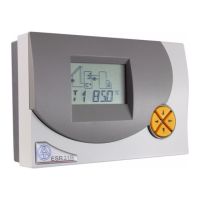39
The setting of the type of volume flow encoder used is made in menu "SENSOR".
A volume flow encoder can only be connected to input S3.
S3 = KTY, PT, GBS, fixed value, accept value, digital, OFF or VTS (Vortex temperature)
= No volume flow encoder
S3 = VF2 (vortex sensor 2-40l/min)
A vortex volume flow encoder (electronic volume flow encoder VFS 2-40) is connect-
ed to input S3.
S3 = VSG
The volume flow encoder on input 3 is a type with pulse encoder.
ON/OFF select / disable heat counter (ex works = OFF)
SSL Sensor input for supply line temperature (ex works = S1)
Setting range: S1 to S3 Input of the pre-run sensor
E1 to E6 Value from external sensor
SRL Sensor input for return line temperature (ex works = S2)
Setting range: S1 to S3 Input of the return sensor
E1 to E6 Value from external sensor
VSG Sensor input for volume flow encoder. (ex works = --)
Settings: VSG S3 = Volume flow encoder on input 3
VSG E1 to E6 = Value from external sensor
VSG -- = no volume flow encoder fixed volume flow. For
the heat quantity calculation the fixed setting of the
volume flow is taken, however only if the set output is
activated. (pump runs)
LPP Litres per pulse = the volume flow encoder’s pulse rate (only when a pulse en-
coder is used) It depends on the system. The sensor supplied by the manufactur-
er of the control unit has a pulse rate of 0.5 litres per pulse. (ex works = 0.5)
Setting range: 0.0 to 10.0 litres/pulse in increments of 0.1 litre/pulse
V Volume flow in litres per hour. If no volume flow encoder has been set, a fixed
volume flow can be preset in this menu. If a set output is not active, the volume
flow is assumed to be 0 litres/hour.
As activated speed control can produce constant changes in volume flow, this
method is not suited to use with speed control. (ex works = 50 l/h)
Setting range: 0 to 20000 litres/hour in increments of 10 litre/hour
SA Share of antifreeze in the heat transfer medium. An average has been calculated
from the product specifications of all of the major manufacturers; this average is
used in the table of mixing ratios. This method generally produces an additional
maximum error of one percent. (ex works = 0%)
Setting range: 0 to 100% in increments of 1%

